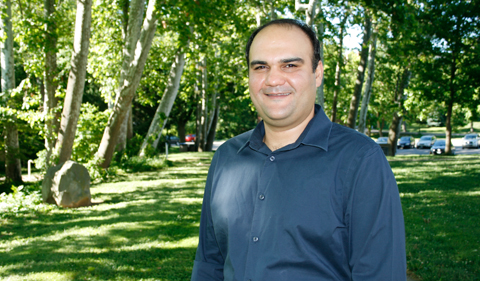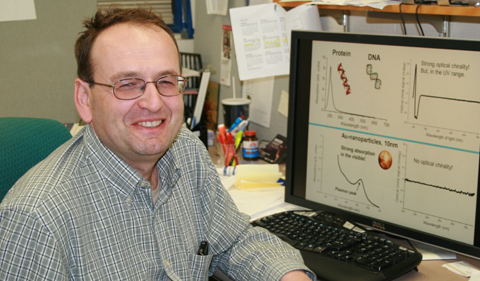Ohio University alum Larousse Khosravi Khorashad and Dr. Alexander Govorov co-authored an article on “Hot Electrons Generated in Chiral Plasmonic Nanocrystals as a Mechanism for Surface Photochemistry and Chiral Growth” in the Journal of the American Chemical Society.
Khorashad earned a Ph.D. in Physics from the College of Arts & Sciences in 2017. In 2018-19, he did his postdoctoral research in Govorov’s group. Presently, he is a postdoc at the University of Nebraska-Lincoln.
Their co-authors are Lucas V. Besteiro and Zhiming M. Wang of the University of Electronic Science and Technology of China; Miguel A. Correa-Duarte from the Universidade de Vigo in Spain; and Sven Burger from the Zuse Institute Berlin in Germany.
Abstract: The realization of chiral photochemical reactions at the molecular level has proven to be a challenging task, with invariably low efficiencies originating from very small optical circular dichroism signals. On the contrary, colloidal nanocrystals offer a very large differential response to circularly polarized light when designed with chiral geometries. We propose taking advantage of this capability, introducing a novel mechanism driving surface photochemistry in a chiral nanocrystal. Plasmonic nanocrystals exhibit anomalously large asymmetry factors in optical circular dichroism (CD), and the related hot-electron generation shows in turn a very strong asymmetry, serving as a mechanism for chiral growth. Through theoretical modeling, we show that chiral plasmonic nanocrystals can enable chiral surface growth based on the generation of energetic (hot) electrons. Using simple and realistic phenomenological models, we illustrate how this kind of surface photochemistry can be observed experimentally. The proposed mechanism is efficient if it operates on an already strongly chiral nanocrystal, whereas our proposed mechanism does not show chiral growth for initially nonchiral structures in a solution. The asymmetry factors for the chiral effects, driven by hot electrons, exceed the values observed in chiral molecular photophysics at least 10-fold. The proposed chiral-growth mechanism for the transformation of plasmonic colloids is fundamentally different to the traditional schemes of chiral photochemistry at the molecular level.

















Comments